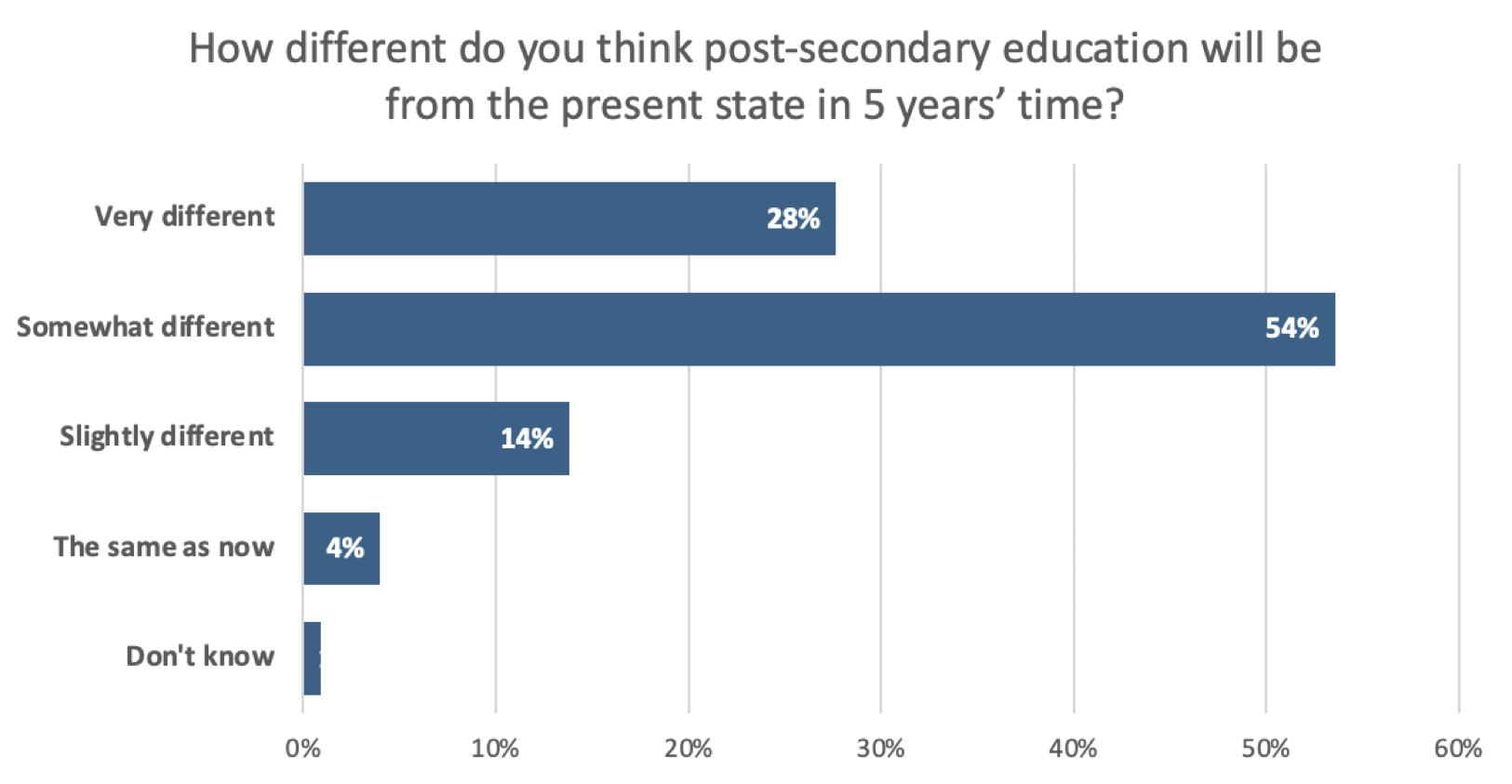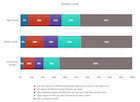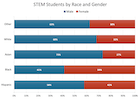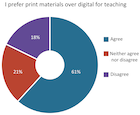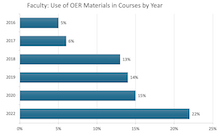Research Briefs
Inclusive Access billing preferences
The majority of our survey respondents agree: students are best served when offered a choice of how to procure their course materials. That both faculty and administrators in these nationally representative samples are united in this opinion is especially noteworthy, as their belief that inclusive access programs should be opt-in stems from direct experience and interaction with higher education students, day in and day out. Their perspectives are valuable, and an important element to consider as the debate surrounding inclusive access billing continues.
Looking Ahead to 2028: Faculty Speculations about the Future of Higher Education
This study investigated faculty perceptions of the near future, their feelings of preparedness (especially if they expect continued change), and gauge their feelings of optimism or pessimism about what the future might bring. Overall, the findings show that most faculty expect higher education in 2028 to be different from the present state. Most respondents also feel prepared for coming change, at least to some extent. Over one-half of faculty reported feelings of pessimism toward the overall future of higher education; however, when asked about their personal future in higher education, feelings of optimism were higher.
Are Students Prepared for Success in Higher Education?
As part of our ongoing research on the evolution of education in the U.S., Bay View Analytics surveyed K-12 and higher education teachers and administrators in April 2024 on their perceptions of student readiness for higher education.
All respondents were asked the same two questions:- Do you believe your students are/were prepared to be successful in their in higher education efforts?
- Do you believe your students are/were prepared to be successful for the use of digital tools and online education in higher education?
Professional development (PD): Improving utility and faculty opinions
The better prepared that faculty members feel about their courses, the more effective they believe them to be for their students. Faculty planning and preparation can take multiple forms, with institutional-provided professional development (PD) being one of the more common. Our research indicates that faculty professional development can be very impactful, and institutions should consider how to reach more faculty with quality professional development options.
OER Adoption Linked to Cost Saving Initiatives and Institutional Support
Awareness remains a key barrier to the adoption of open educational resources (OER). Two-thirds of faculty respondents reported some level of awareness of OER, and 41% of that number first heard about OER from an institution-level program or initiative. These institution-driven initiatives represent a unique opportunity to reach educators right on campus, and influence perspectives on OER. In this research brief, we present our findings, and explore how best to reach faculty and administrators.
Growing OER Awareness in K-12 – Introduction Methods for OER
OER awareness is generally lower amongst K-12 teachers — in our most recent study, just 17% of respondents report some level of awareness. In this research brief we take a look at how these educators first learned about OER, to better understand how to reach them. OER awareness in K-12 educators is growing slowly, lagging considerably behind higher education faculty. Teachers most commonly cited doing their own research as the source of their knowledge on OER, while administrators appear receptive to professional conferences, meetings, and webinars. In order to bolster the spread of OER awareness in the K-12 segment, OER advocates will need to devise methods to reach unaware faculty who are potentially seeking resources to help meet their teaching goals.
Two-thirds of Faculty are aware of OER — let's explore how and why
The most common source of information on OER is right on campus, from colleagues or institutional-level programs. Nearly half (47%) of faculty report first hearing about OER from a peer. We call these "one-on-one" discoveries, which might result from casual conversation — "Hey, look what I found" — or to help fill a specific request, such as looking for a resource to help cover a topic.
Digital and OER Textbook Adoption
The global COVID-19 pandemic changed how faculty teach, and resulted in a large rise in digital curricula use. We partnered with the Brian Murphy Group to investigate how the digital adoption trend varied across different course disciplines. The study examines selected large-enrollment introductory-level courses for the Fall 2020, Fall 2021, and Fall 2022 terms. The shifts in perspectives on digital learning is part a growing acceptance of digital materials that we've been monitoring for years. During the 2018-2019 academic year, 44% of faculty agreed with the statement "Students learn better form print materials than they do from digital." By the 2021 - 2022 academic year, that figure dropped to 33%. In the same academic year, the majority of faculty and administrators expressed agreement with the statement "Digital materials provide greater flexibility for students." Only a small number disagree with the statement (5% faculty, 4% administrators), with only 1% of faculty strongly disagreeing.
The results show that print textbooks remain a dominant form factor. But the growing demand for digital textbooks speaks to where demand may be heading.
Faculty Satisfaction with Course Materials varies by Publisher
As part of our research into faculty satisfaction with curricula, we took a look at how satisfaction varies by publisher type, comparing major commercial publishers, smaller commercial publishers, and OER, and measured how OER fares across several factors. The study examines multiple aspects: overall, accuracy, scope of content, included instructor materials, and cost to student.
K-12 Teacher Demographics are strongly correlated to OER Awareness
Bay View Analytics, with support from the Hewlett Foundation, conducts annual, national surveys of K-12 teachers and administrators on topics related to curricula adoption, and tracking awareness levels of Open Educational Resources (OER). To compare our results with those from similar K-12 teacher panels we participated as a researcher in the Rand Organization’s Fall 2022 Omnibus Survey, submitting questions for its American Teacher Panel. This panel is a nationally representative sample of educators who regularly provide feedback on important issues of educational policy and practice. The Rand organization’s dataset allowed us to explore further, gathering more details on how specific school and teacher variables are related to OER awareness levels.
What Makes a STEM Student
Are there unique attributes to the one-third of students who are studying STEM, compared to non-STEM students? We can start to answer this question using data from the Digital Learning Pulse Survey. We investigated the demographics of current STEM students using the representative sample of 2,358 college students collected during the Fall of 2022. Indeed, we found that there are differences in the underlying attributes of STEM and non-STEM students.
Digital curricula acceptance and use in Higher Education varies by region
Online learning and digital tools and materials have seen increased acceptance and adoption in the US, spurred in part by online teaching experiences during the pandemic. But not all faculty agree, and opinions seem to fall along a geographic divide: acceptance of online learning is highest on the west coast, and lowest in the east.
Teachers believe the future of K-12 classroom materials is digital
Five charts that predict a digital-first future for K-12 classrooms in the United States.
The pandemic required K-12 teachers to adopt and use digital materials as many traditional options did not work in this new remote-classroom setting. For the 2021-22 school year there was a vast return to the classroom, however, these teachers now had experience with digital tools. Will they incorporate their new digital materials with their traditional physical in-person classroom materials? Was the pandemic switch to digital a one-time blip, or does it predict more long-term adoption of digital?
Open Educational Resources: Becoming Mainstream
Bay View Analytics has been tracking awareness, adoption, use, and attitudes toward open educational resources in U.S. Higher Education since 2009. A lot has changed.
- OER Awareness amongst US. Higher Education faculty and administrators went from almost nonexistent in 2009, to 57% “Somewhat Aware,” “Aware,” or “Very Aware” in 2022
- The number of respondents who use OER materials as required courseware lags behind the metric for OER Awareness, but these levels also grew year over year
- OpenStax has become a viable alternative to commercial publishers
- Faculty give OER materials higher marks for quality than they do for commercial alternatives
Perceptions of the Future of STEM Education
A Fall 2020 survey of STEM faculty found differing levels of optimism for the future of post-secondary STEM education. The results show that, while the majority of all respondents are optimistic, some subgroups are significantly more optimistic about the future of post-secondary STEM education overall and are also more optimistic about their personal role in higher education in the future.
Perspectives: COVID-19, and the future of higher education
A survey of U.S. higher education’s immediate priorities and response to the global COVID-19 pandemic highlights the concerns and insights faced by academic institutions while deploying emergency distance education during the Spring 2020 academic term.
Recent Publications
Open Educational Resources
- Approaching a New Normal? Educational Resources in U.S. Higher Education, 2024
- Conflicted Digital Adoption: Educational Resources in U.S. K-12 Education, 2024
- Research Brief: Digital and OER Textbook Adoption
- Research Brief: Faculty Satisfaction with Course Materials varies by Publisher
Course Material Affordability
Digital Learning Pulse Surveys
- Infographic: 2023-2024 Digital Learning Pulse Survey
- The Digital Transformation of the Community College
- Planning for a Smaller Future: Dealing with Declining Enrollments
STEM
- Teaching Online: STEM Education in the Time of COVID
- What Makes a STEM Student
- Perceptions of the Future of STEM Education
Distance Education
- Digital Faculty: Faculty Social Media Use and Communications
- Infographic: Digital Faculty
- Grade Increase: Tracking Distance Education in the United States
Follow us on
Privacy
All survey respondents are provided complete anonymity. No personally identifiable information is released. Full privacy policy.
